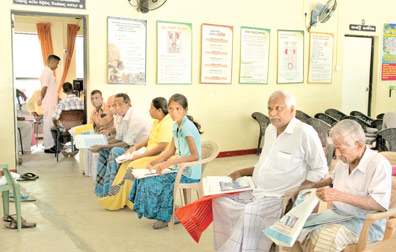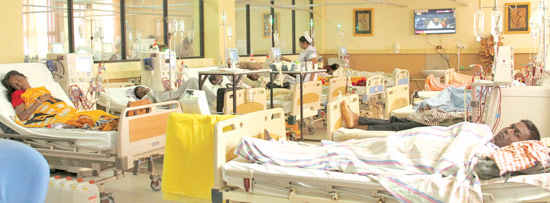Toxic truths
Chronic kidney failure has become an everyday reality
for many families but what causes it still remains a mystery, though
cadmium is increasingly being identified as a dominant culprit:
by Dhaneshi Yatawara
 |
|
CKDu unit functioning at
the Anuradhapura hospital |
Chronic kidney disease which hit the headlines of late where a common
causative factor cannot be attributed, is placing a heavy burden on the
farming community in particular and the country as a whole. Chronic
Disease of unknown etiology (CKDu) is detected in parts of other
provinces such as Uva, North, and Eastern apart from concentrated areas
in and around the North Central and North Western Provinces.
Experts in the field and many concerned Sri Lankans continue to
discuss and debate the issue. Attention at this time of the year on
kidney disease is focussed more as we just marked World Kidney Day a few
days ago. Every year, the second Thursday in March is set aside for
World Kidney Day, bringing special attention to this life-threatening
condition.
Cause
However, many scientists argue otherwise about the cause of the
disease. They question as to whether identifying Cadmium as being the
cause and whether the method by which it enters the body is the reason
for this deadly disease. They say that if this was the reason, then the
whole country should be affected by CKDu like the NCP (Rajarata),
because the Rajarata is the main rice producing area in the country.
The research by Myles F. Elledge, Jennifer Hoponick Redmon, Keith E.
Levine, Rajitha J. Wickremasinghe, Kamani P. Wanigasariya, and Roshini
J. Peiris-John in 2014, revealed that although Sri Lanka is known for
its strong public health system, data on Non Communicable Disease, CKDu
deaths and disease show a severe shortfall. According to researchers,
investigations done so far have narrowly viewed only one variable or
potential risk factor. A recent study was undertaken by Dr. Anjali
Shastri from the US State Department on the connectivity between
policies and research done so far in Sri Lanka. "CKDu is curable and
preventable if the cause is known," Dr. Shastri said.
Based on a field survey done over two months in affected areas in the
NCP, NWP, Western and Uva Provinces, Dr. Shastri was of the view that
the efforts taken by the Government and interested parties to find a
solution to the problem was not effective due to the unknown cause of
the disease.
 |
|
Kidney patients awaiting
treatment |
"The Government has done much to bring relief to those affected.
But scientists and the Government mechanism must network, to find the
cause and cure without delay," she said.
She advocated several steps, including control over the use of
fertiliser, pesticides and weedicides to prevent CKDu occurence,
regulation over the use of agrochemicals, establishing laboratory
facilities to frequently test fertiliser, pesticides and weedicides,
strengthening awareness.
A legal framework to combat the indiscriminate use of pesticides and
promote environment-friendly agriculture was also a pre requisite, she
said.
In her study with the Coordinating Secretariat for Science and
Technology Innovation (COSTI), she was informed that there were nearly
180 publications on CKDu but only 17 of them have been reviewed by peer
groups.
Shortage
"It was evident that a shortage of medical staff was a huge barrier
for the Ministry of Health to conduct screening and tests for early
detection," she said adding that, however, there must be a mechanism for
early detection as it is essential to slow the disease from progressing.
Today, CKDu, although
detected in parts of the Uva, North, and Eastern Provinces, is also
prevalent in and around the North Central Province(NCP) and the North
Western Provinces (NWP) as well.
According to a spokesperson of the Presidential Task Force on Chronic
Kidney Disease, a new phase of screening for patients islandwide has
been initiated by the Health Ministry. With the new screening, 11
districts have been identified as risk areas so far. i.e. Anuradhapura,
Polonnaruwa, Moneragala, Badulla, Matale, Kurunegala, Vavuniya,
Mulaitivu, Trincomalee, Ampara and Hambantota. "The number of patients
will change as the screening progresses to more districts," the
spokesman said.
"Following earlier research plus screening programs conducted mainly
in the NCP and NWP, the number of patients was estimated to be around
40,680 and the new program will enable a better picture of the
situation," he said. Based on a WHO finding, Dr. Kamal Gammanpila, a
retired medical scientist based in the UK with a keen interest on the
Sri Lankan CKDu situation blamed the cause for CKDu in the (NCP)
Rajarata to toxic diets. "Cadmium is the dominant toxic agent," said Dr.
Gammanpila. As a solution, he recommended a change in the diet.
 |
|
Dialysis patients at the
Anuradhapura hospital. |
"There is enough research done on water, food and soil in these areas
for any scientist to analyse and reach a conclusion. By going through
these figures a better understanding can be reached," Dr. Gammanpila
said.
He argued that Cadmium gets into the body by consuming locally grown
rice, vegetables and yams grown in highly toxic soil as well as by
drinking water from these areas.
He explained that heavy metals get infused into the soil and the food
chain which begins with fertiliser being applied to the fields and
irrigation water entering the body.
Dialysis
"Although canal and reservoir water is low in heavy metal toxic
levels, using it as irrigation water makes it a toxic contributor," he
said. All these elements are harmful to the body and cause multiple
ailments. Cadmium is a well-established agent which causes kidney
failure, he said.
"Our failure to address this issue is causing avoidable deaths. It
has been so for some time now," Dr. Gammanpila said.
Thousands of CKDu patients currently depend on dialysis machines to
clean their blood from accumulating toxics. The available machines do
not support the patient demand. The nearest hospital for the CKDu hot
spot Rajarata is the Anuradhapura Teaching Hospital.
The dialysis ward of the renal unit is equipped with 25 beds and
performs nearly 1980 dialysis per day, according Dr. Lionel Muhandiramge,
Anuradhapura Teaching Hospital Director.
The hospital's transplant unit has performed nearly 48 kidney
transplants between 2012 and 2015, according to hospital statistics. The
unit registers 200 to 250 new patients monthly.
The renal unit and the transplant unit cater to patients from the NCP,
the Northern Province and the Eastern Province, said Dr. Muhandiramge
explaining the big demand the hospital has to cater to, despite
government support to start kidney transplants at the Polonnaruwa
General Hospital.
The Anuradhapura Teaching Hospital will get a new building providing
accommodation for patients who need to wait a day or two for dialysis,
said Dr. Muhandiramge. Accordingly funds are allocated through the
Provincial Ministry of Health.
Today CKDu is a global public health concern. Following numerous
investigative efforts, testing for levels of Cadmium, Arsenic and many
other heavy metals and for chemicals such as floride in water and soil
and studies on rice, vegetables and yams, researchers and medical
experts are still unable to find a clear reason for CKDu prevalence in
the country.
Pix: Mahinda Vithanachchi |

